HONDA INSIGHT 2005 1.G Owner's Guide
Manufacturer: HONDA, Model Year: 2005, Model line: INSIGHT, Model: HONDA INSIGHT 2005 1.GPages: 218, PDF Size: 2.7 MB
Page 31 of 218
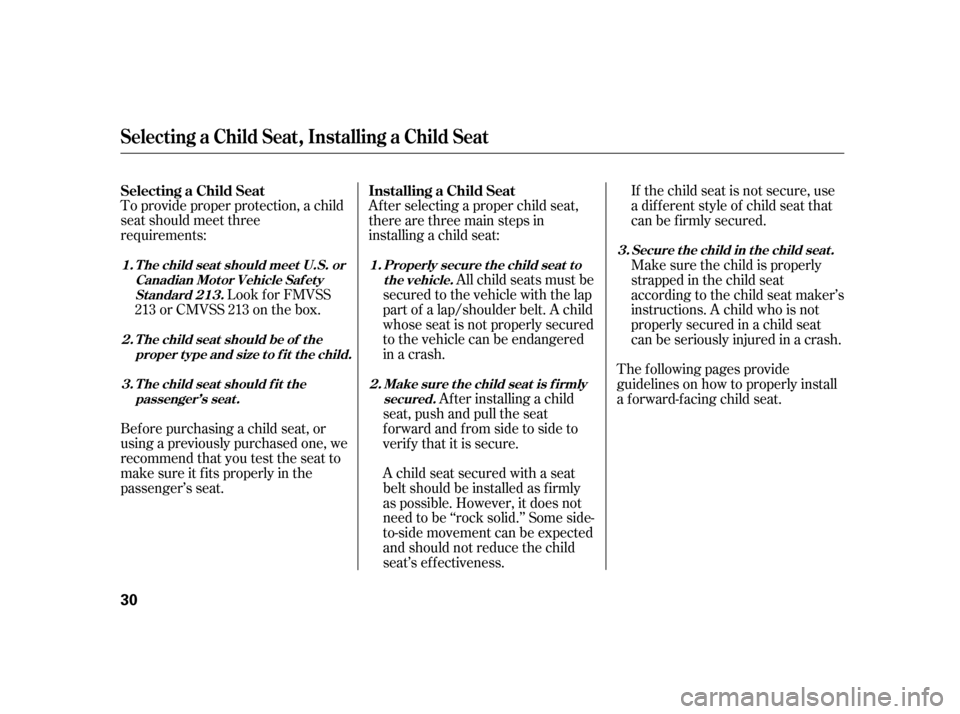
To provide proper protection, a child
seat should meet three
requirements:Look f or FMVSS
213 or CMVSS 213 on the box.
Bef ore purchasing a child seat, or
using a previously purchased one, we
recommend that you test the seat to
make sure it f its properly in the
passenger’s seat. Af ter selecting a proper child seat,
there are three main steps in
installing a child seat:
All child seats must be
secured to the vehicle with the lap
part of a lap/shoulder belt. A child
whose seat is not properly secured
to the vehicle can be endangered
in a crash.
Af ter installing a child
seat, push and pull the seat
f orward and f rom side to side to
verif y that it is secure.
A child seat secured with a seat
belt should be installed as f irmly
as possible. However, it does not
need to be ‘‘rock solid.’’ Some side-
to-side movement can be expected
and should not reduce the child
seat’s ef f ectiveness. If the child seat is not secure, use
a dif f erent style of child seat that
can be f irmly secured.
Make sure the child is properly
strappedinthechildseat
according to the child seat maker’s
instructions. A child who is not
properly secured in a child seat
canbeseriouslyinjuredinacrash.
The f ollowing pages provide
guidelines on how to properly install
a f orward-f acing child seat.
Selecting a Child Seat
Installing a Child Seat
T he child seat should meet U.S. or
Canadian Mot or Vehicle Saf et ySt andard 213.
T he child seat should be of theproper t ype and size t o f it t he child.
T he child seat should f it thepassenger’s seat . Properly secure t he child seat t o
the vehicle.
Make sure t he child seat is f irmlysecured. Secure the child in the child seat.
1.
2.3. 1.
2. 3.
Selecting a Child Seat, Installing a Child Seat
30
Page 32 of 218
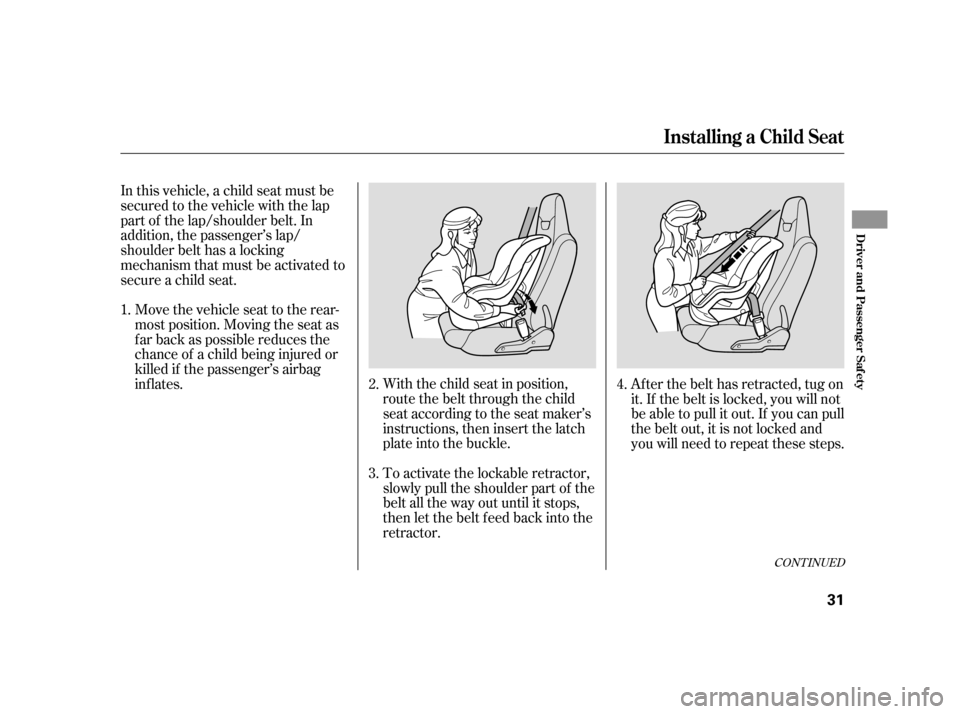
With the child seat in position,
route the belt through the child
seat according to the seat maker’s
instructions, then insert the latch
plate into the buckle.
To activate the lockable retractor,
slowly pull the shoulder part of the
belt all the way out until it stops,
then let the belt f eed back into the
retractor.
In this vehicle, a child seat must be
secured to the vehicle with the lap
part of the lap/shoulder belt. In
addition, the passenger’s lap/
shoulder belt has a locking
mechanism that must be activated to
secure a child seat.
Move the vehicle seat to the rear-
most position. Moving the seat as
f ar back as possible reduces the
chance of a child being injured or
killed if the passenger’s airbag
inflates. After the belt has retracted, tug on
it. If the belt is locked, you will not
be able to pull it out. If you can pull
the belt out, it is not locked and
you will need to repeat these steps.
1.
2.
3.4.
CONT INUED
Installing a Child Seat
Driver and Passenger Saf ety
31
Page 33 of 218
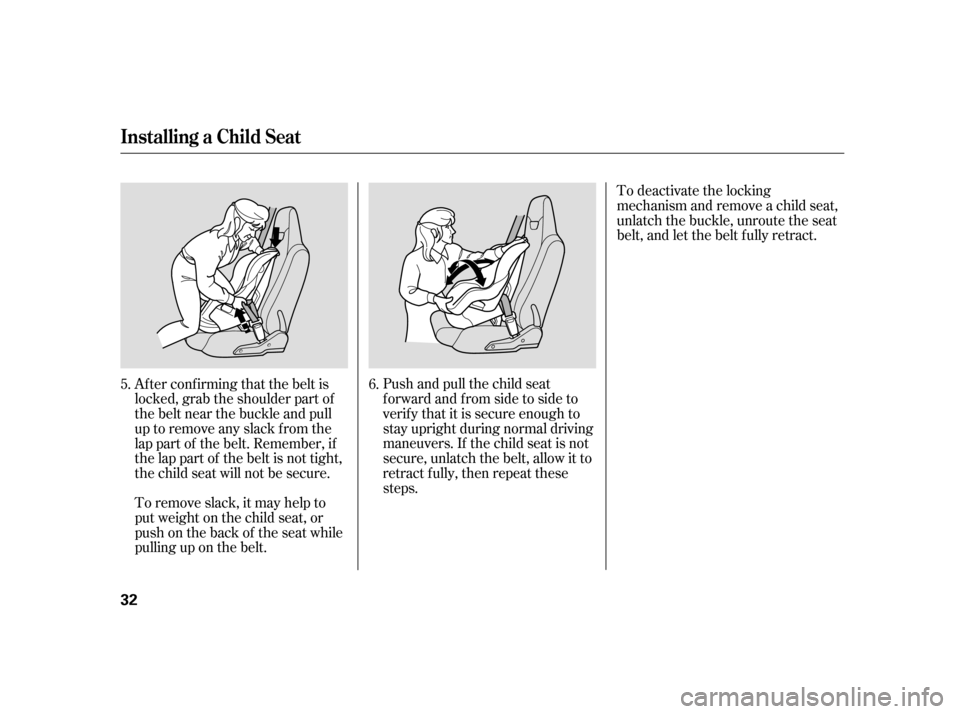
To remove slack, it may help to
putweightonthechildseat,or
push on the back of the seat while
pulling up on the belt.Push and pull the child seat
f orward and f rom side to side to
verif y that it is secure enough to
stay upright during normal driving
maneuvers. If the child seat is not
secure, unlatch the belt, allow it to
retract f ully, then repeat these
steps.To deactivate the locking
mechanism and remove a child seat,
unlatch the buckle, unroute the seat
belt, and let the belt f ully retract.
Af ter conf irming that the belt is
locked, grab the shoulder part of
the belt near the buckle and pull
up to remove any slack from the
lap part of the belt. Remember, if
the lap part of the belt is not tight,
the child seat will not be secure.
5.
6.
Installing a Child Seat
32
Page 34 of 218
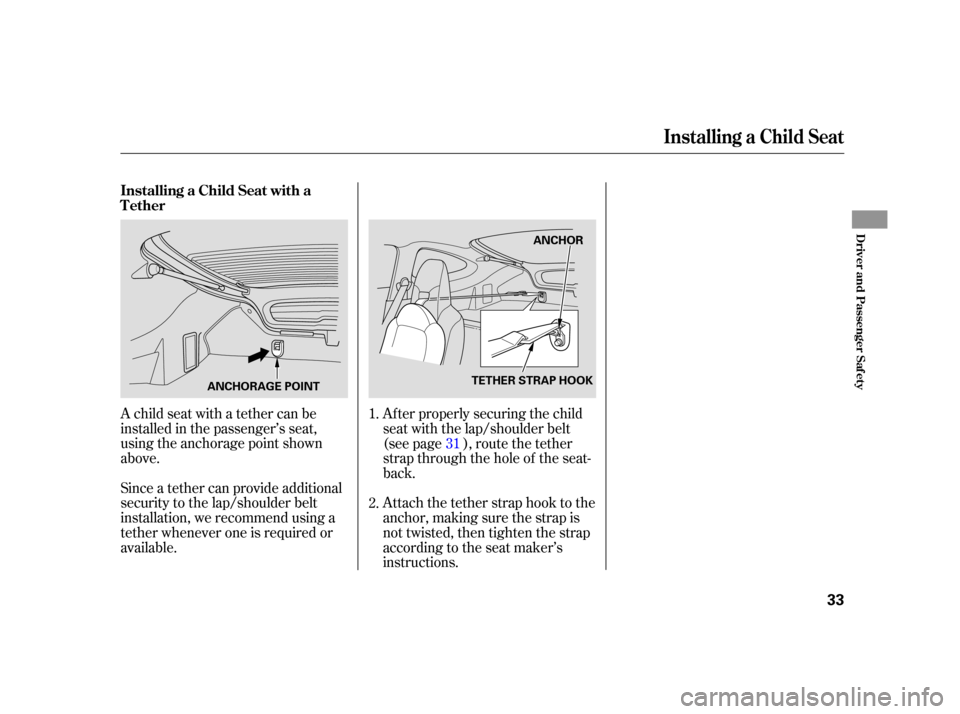
A child seat with a tether can be
installed in the passenger’s seat,
using the anchorage point shown
above.
Since a tether can provide additional
security to the lap/shoulder belt
installation, we recommend using a
tether whenever one is required or
available.Attach the tether strap hook to the
anchor, making sure the strap is
not twisted, then tighten the strap
according to the seat maker’s
instructions. Af ter properly securing the child
seat with the lap/shoulder belt
(see page ), route the tether
strapthroughtheholeof theseat-
back.
1.
2. 31
Installing a Child Seat
Installing a Child Seat with a
Tether
Driver and Passenger Saf ety
33
ANCHORAGE POINT
TETHER STRAP HOOKANCHOR
Page 35 of 218
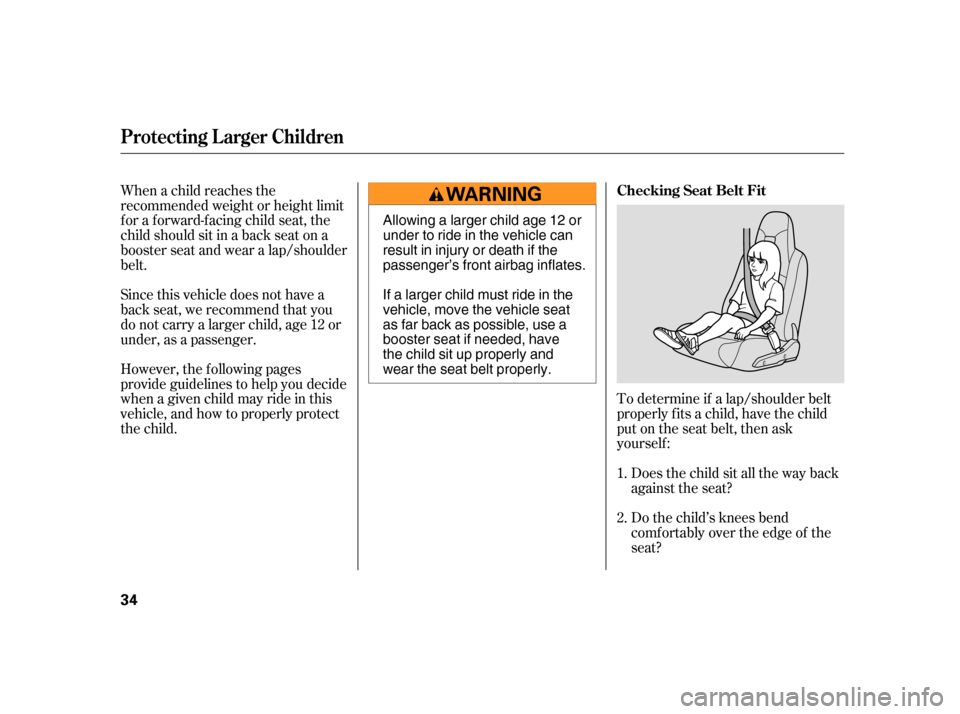
When a child reaches the
recommended weight or height limit
for a forward-facing child seat, the
child should sit in a back seat on a
booster seat and wear a lap/shoulder
belt.To determine if a lap/shoulder belt
properly f its a child, have the child
put on the seat belt, then ask
yourself :Does the child sit all the way back
against the seat?
Do the child’s knees bend
comf ortably over the edge of the
seat?
Since this vehicle does not have a
back seat, we recommend that you
do not carry a larger child, age 12 or
under, as a passenger.
However, the following pages
provide guidelines to help you decide
when a given child may ride in this
vehicle, and how to properly protect
the child.
1.
2. Checking Seat Belt Fit
Protecting L arger Children
34
Allowing a larger child age 12 or
under to ride in the vehicle can
result in injury or death if the
passenger’s front airbag inflates.
If a larger child must ride in the
vehicle, move the vehicle seat
as far back as possible, use a
booster seat if needed, have
the child sit up properly and
wear the seat belt properly.
Page 36 of 218

Does the shoulder belt cross
between the child’s neck and arm?
Is the lap part of the belt as low as
possible, touching the child’s
thighs?
Will the child be able to stay
seated like this f or the whole trip?
If you answer yes to all these
questions, the child is ready to wear
the lap/shoulder belt correctly. If
you answer no to any question, the
child needs to ride on a booster seat. A child who has outgrown a f orward- f acing child seat should use a
booster seat until the lap/shoulder
belt fits them properly without the
booster.
Some states and Canadian provinces
also require children to use a booster
seat until they reach a given age or
weight (e.g., 6 years or 60 lbs). Be
sure to check current laws in the
states or provinces where you intendto drive.
Booster seats can be high-back or
low-back. Whichever style you select,
make sure the booster meets f ederal
saf ety standards and that you f ollow
the booster seat maker’s instructions.
If a child who uses a booster seat
ridesinthisvehicle,movethe
vehicle seat as f ar to the rear as
possible, and be sure the child is
wearing the seat belt properly.
A child may continue using a booster
seat until the tops of their ears are
even with the top of the vehicle’s or
booster’s seat-back. A child of this
height should be tall enough to use
the lap/shoulder belt without a
booster seat.
3.
4.
5.
Using a Booster Seat
Protecting L arger Children
Driver and Passenger Saf ety
35
Page 37 of 218
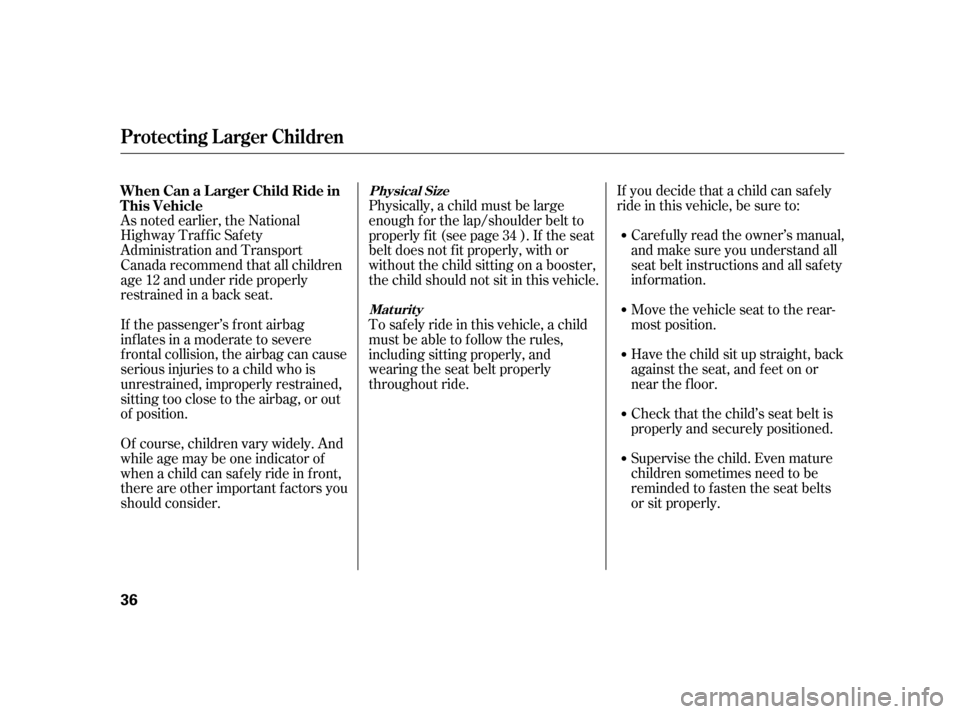
If you decide that a child can saf ely
ride in this vehicle, be sure to:Caref ully read the owner’s manual,
and make sure you understand all
seat belt instructions and all saf ety
inf ormation.
Move the vehicle seat to the rear-
most position.
Have the child sit up straight, back
against the seat, and feet on or
near the f loor.
Check that the child’s seat belt is
properly and securely positioned.
Supervise the child. Even mature
children sometimes need to be
reminded to f asten the seat belts
or sit properly.
As noted earlier, the National
Highway Traffic Safety
Administration and Transport
Canada recommend that all children
age 12 and under ride properly
restrained in a back seat.
If the passenger’s f ront airbag
inf lates in a moderate to severe
f rontal collision, the airbag can cause
serious injuries to a child who is
unrestrained, improperly restrained,
sitting too close to the airbag, or out
of position.
Physically, a child must be large
enough f or the lap/shoulder belt to
properly f it (see page ). If the seat
belt does not f it properly, with or
without the child sitting on a booster,
the child should not sit in this vehicle.
To saf ely ride in this vehicle, a child
must be able to f ollow the rules,
including sitting properly, and
wearing the seat belt properly
throughout ride.
Of course, children vary widely. And
while age may be one indicator of
when a child can saf ely ride in f ront,
there are other important f actors you
should consider. 34
When Can a L arger Child Ride in
This VehiclePhysical Size
Maturity
Protecting L arger Children
36
Page 38 of 218
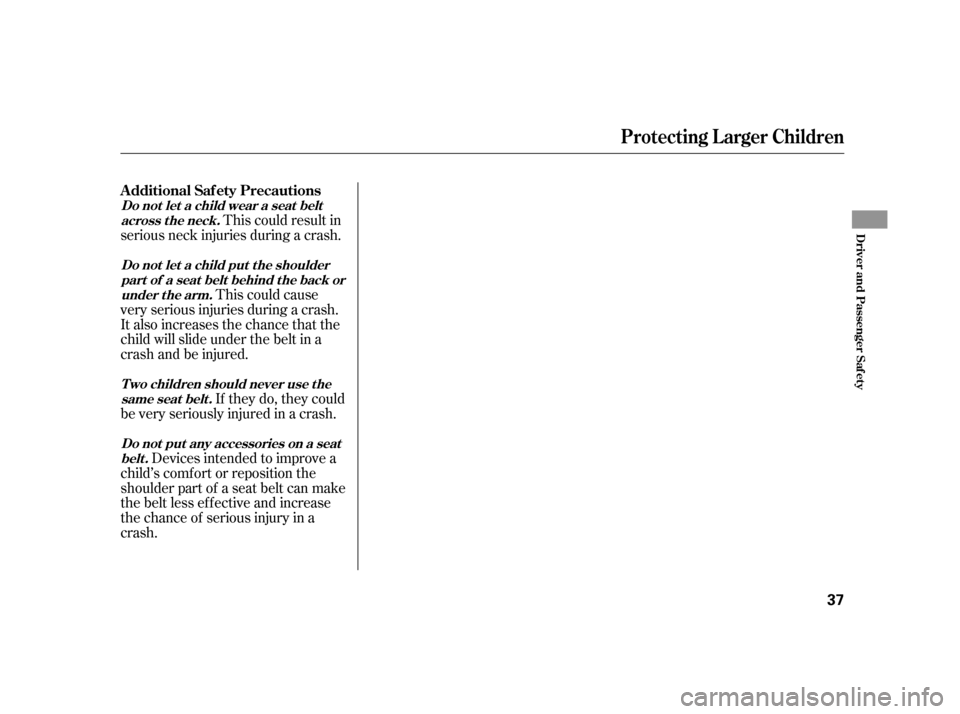
This could result in
serious neck injuries during a crash.
This could cause
very serious injuries during a crash.
It also increases the chance that the
child will slide under the belt in a
crash and be injured.
If they do, they could
be very seriously injured in a crash.
Devices intended to improve a
child’s comf ort or reposition the
shoulder part of a seat belt can make
the belt less ef f ective and increase
the chance of serious injury in a
crash. Additional Saf ety Precautions
Do not let a child wear a seat belt
across t he neck.
Do not let a child put the shoulderpart of a seat belt behind t he back orunder t he arm.
T wo children should never use t hesame seat belt .
Do not put any accessories on a seatbelt.
Protecting L arger Children
Driver and Passenger Saf ety
37
Page 39 of 218
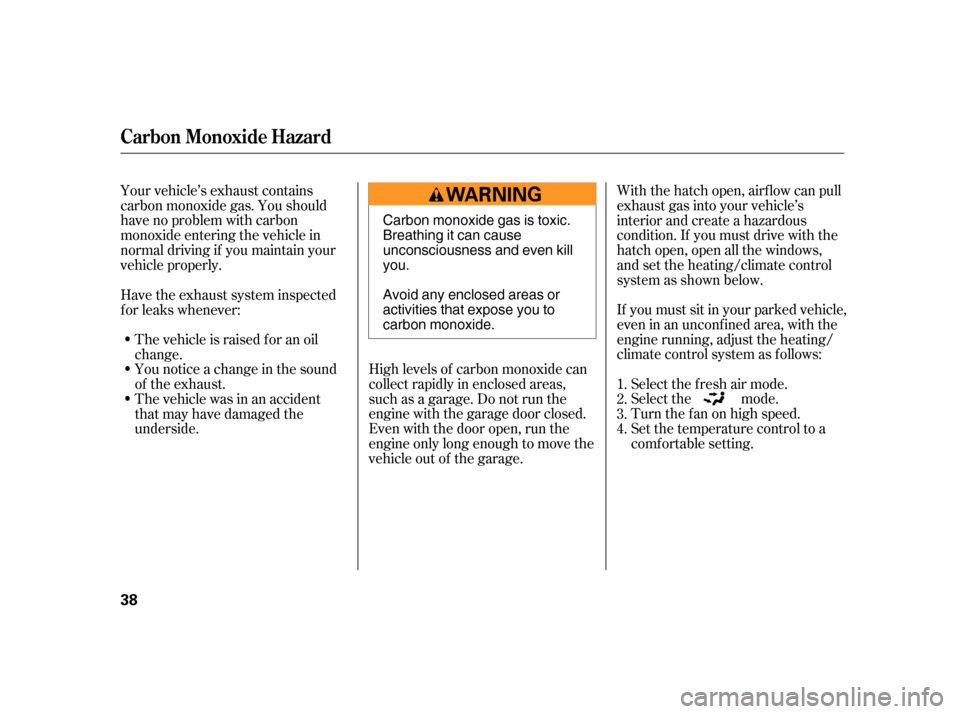
Your vehicle’s exhaust contains
carbon monoxide gas. You should
have no problem with carbon
monoxide entering the vehicle in
normal driving if you maintain your
vehicle properly.With the hatch open, airflow can pull
exhaust gas into your vehicle’s
interior and create a hazardous
condition. If you must drive with the
hatch open, open all the windows,
and set the heating/climate control
system as shown below.
If you must sit in your parked vehicle,
even in an unconf ined area, with the
engine running, adjust the heating/
climate control system as f ollows:
Select the f resh air mode.
Select the mode.
Turn the f an on high speed.
Set the temperature control to a
comfortable setting.
High levels of carbon monoxide can
collect rapidly in enclosed areas,
such as a garage. Do not run the
engine with the garage door closed.
Even with the door open, run the
engine only long enough to move the
vehicle out of the garage.
The vehicle is raised f or an oil
change.
You notice a change in the sound
of the exhaust.
The vehicle was in an accident
that may have damaged the
underside.
Have the exhaust system inspected
f or leaks whenever:
1.
2.
3.
4.
Carbon Monoxide Hazard
38
Carbon monoxide gas is toxic.
Breathing it can cause
unconsciousness and even kill
you.
Avoid any enclosed areas or
activities that expose you to
carbon monoxide.
Page 40 of 218

These labels are in the locations
shown. They warn you of potential
hazards that could cause serious
injury. Read these labels caref ully.
If a label comes of f or becomes hard
to read (except for the U.S.
dashboard label which may be
removed by the owner), contact your
dealer f or a replacement.U.S. modelsCanadian models
U.S. models only
Saf ety L abels
Driver and Passenger Saf ety
39
BATTERY
SUN VISOR
HOOD RADIATOR CAP
DASHBOARD